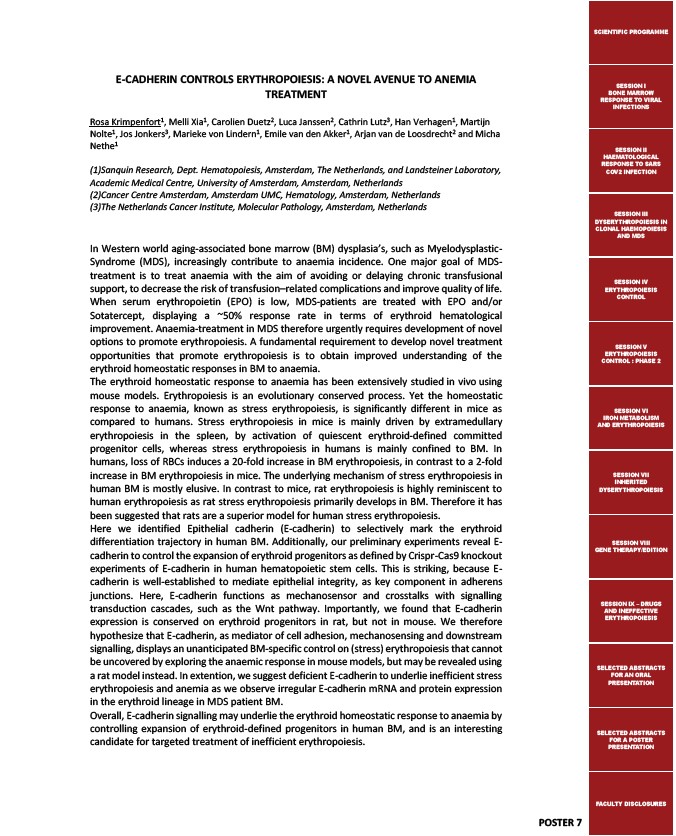
E-CADHERIN CONTROLS ERYTHROPOIESIS: A NOVEL AVENUE TO ANEMIA
TREATMENT
Rosa Krimpenfort1, Melli Xia1, Carolien Duetz2, Luca Janssen2, Cathrin Lutz3, Han Verhagen1, Martijn
Nolte1, Jos Jonkers3, Marieke von Lindern1, Emile van den Akker1, Arjan van de Loosdrecht2 and Micha
Nethe1
(1)Sanquin Research, Dept. Hematopoiesis, Amsterdam, The Netherlands, and Landsteiner Laboratory,
Academic Medical Centre, University of Amsterdam, Amsterdam, Netherlands
(2)Cancer Centre Amsterdam, Amsterdam UMC, Hematology, Amsterdam, Netherlands
(3)The Netherlands Cancer Institute, Molecular Pathology, Amsterdam, Netherlands
I
n Western world aging-associated bone marrow (BM) dysplasia’s, such as Myelodysplastic-
Syndrome (MDS), increasingly contribute to anaemia incidence. One major goal of MDS-treatment
is to treat anaemia with the aim of avoiding or delaying chronic transfusional
support, to decrease the risk of transfusion–related complications and improve quality of life.
When serum erythropoietin (EPO) is low, MDS-patients are treated with EPO and/or
Sotatercept, displaying a ~50% response rate in terms of erythroid hematological
improvement. Anaemia-treatment in MDS therefore urgently requires development of novel
options to promote erythropoiesis. A fundamental requirement to develop novel treatment
opportunities that promote erythropoiesis is to obtain improved understanding of the
erythroid homeostatic responses in BM to anaemia.
The erythroid homeostatic response to anaemia has been extensively studied in vivo using
mouse models. Erythropoiesis is an evolutionary conserved process. Yet the homeostatic
response to anaemia, known as stress erythropoiesis, is significantly different in mice as
compared to humans. Stress erythropoiesis in mice is mainly driven by extramedullary
erythropoiesis in the spleen, by activation of quiescent erythroid-defined committed
progenitor cells, whereas stress erythropoiesis in humans is mainly confined to BM. In
humans, loss of RBCs induces a 20-fold increase in BM erythropoiesis, in contrast to a 2-fold
increase in BM erythropoiesis in mice. The underlying mechanism of stress erythropoiesis in
human BM is mostly elusive. In contrast to mice, rat erythropoiesis is highly reminiscent to
human erythropoiesis as rat stress erythropoiesis primarily develops in BM. Therefore it has
been suggested that rats are a superior model for human stress erythropoiesis.
Here we identified Epithelial cadherin (E-cadherin) to selectively mark the erythroid
differentiation trajectory in human BM. Additionally, our preliminary experiments reveal E-cadherin
to control the expansion of erythroid progenitors as defined by Crispr-Cas9 knockout
experiments of E-cadherin in human hematopoietic stem cells. This is striking, because E-cadherin
is well-established to mediate epithelial integrity, as key component in adherens
junctions. Here, E-cadherin functions as mechanosensor and crosstalks with signalling
transduction cascades, such as the Wnt pathway. Importantly, we found that E-cadherin
expression is conserved on erythroid progenitors in rat, but not in mouse. We therefore
hypothesize that E-cadherin, as mediator of cell adhesion, mechanosensing and downstream
signalling, displays an unanticipated BM-specific control on (stress) erythropoiesis that cannot
be uncovered by exploring the anaemic response in mouse models, but may be revealed using
a rat model instead. In extention, we suggest deficient E-cadherin to underlie inefficient stress
erythropoiesis and anemia as we observe irregular E-cadherin mRNA and protein expression
in the erythroid lineage in MDS patient BM.
Overall, E-cadherin signalling may underlie the erythroid homeostatic response to anaemia by
controlling expansion of erythroid-defined progenitors in human BM, and is an interesting
candidate for targeted treatment of inefficient erythropoiesis.
POSTER 7
SCIENTIFIC PROGRAMME
SESSION I
BONE MARROW
RESPONSE TO VIRAL
INFECTIONS
SESSION II
HAEMATOLOGICAL
RESPONSE TO SARS
COV2 INFECTION
SESSION III
DYSERYTHROPOIESIS IN
CLONAL HAEMOPOIESIS
AND MDS
SESSION IV
ERYTHROPOIESIS
CONTROL
SESSION V
ERYTHROPOIESIS
CONTROL : PHASE 2
SESSION VI
IRON METABOLISM
AND ERYTHROPOIESIS
SESSION VII
INHERITED
DYSERYTHROPOIESIS
SESSION VIII
GENE THERAPY/EDITION
SESSION IX – DRUGS
AND INEFFECTIVE
ERYTHROPOIESIS
SELECTED ABSTRACTS
FOR AN ORAL
PRESENTATION
SELECTED ABSTRACTS
FOR A POSTER
PRESENTATION
FACULTY DISCLOSURES